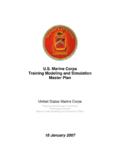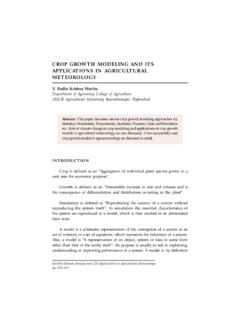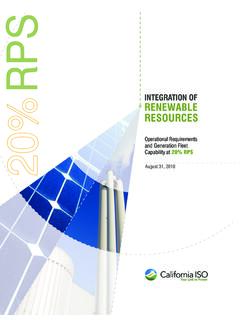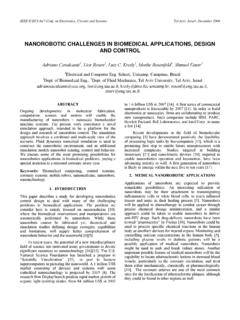Transcription of A Cutting-Edge Approach to Combined-Cycle …
1 INSTRUMENTATION & CONTROLSD ominion s 1,346-MW Warren County Generating Station in Virginia uses a 3-on-1 configuration with Mitsubishis Hitachi Power Systems America 501 GAC combustion turbines. High-efficiency, Combined-Cycle , natural gas-fired plants such as this can ben-efit from high-fidelity plant simulations that allow for virtual training and testing before execution in the real Cutting-Edge Approach to Combined-Cycle Plant SimulationBY KEITH NELSON AND BILLY MOORE overcome these traditional simulator issues. Working in conjunction with Emerson Process Management, Southern Company implemented a unique phased simulator Approach that provides all the benefits of a traditional plant simulator with a significantly reduced maintenance burden and improved long-term sustainability.
2 Unit 3 of Southern Company s Daniel Electric Generating Plant is a 2-on-1 Combined-Cycle facility with a capacity of 530 MW. As is the case with many of the generating plants in the United States, staff turnover has been driving the need for efficient High-fidelity plant simulators are a cornerstone for robust operator training, event replay and analysis, engineering development, and what if analysis. They are beneficial tools to help today s Combined-Cycle power plants address operator turnover, complex operational demands, and ensured reliability. However, it can be very challenging to manage traditional simulators, given the specialized expertise required to develop and maintain custom plant models, and the complexity of maintaining two simulator software platforms both the simulated process models platform and the simulated control system platform.
3 At its Mississippi Power Daniel plant, Southern Company is now implementing a first-of-its-kind, high-fidelity, Combined-Cycle simulator that uses leading-edge technology to AuthorsKeith Nelson is I&C Team leader at Southern Company. Billy Moore is manager of Simulation Projects at Emerson Process & CONTROLSin the control system computing platform. The Emerson simulator includes a complete suite of plant equipment models (algorithms) that are connected in a f low diagram-type structure, modeling plant systems in a hierarchical manner and ensuring continuous adherence to the laws of thermodynamics, fundamentals of heat transfer, and fundamentals of f luid mechanics.
4 Ultimately, this results in a high-fidelity model of the of Maintenance With embedded simulation, standard control system engineering tools are used to construct the plant system models in exactly the same way they are used to construct control logic systems. Modifications to plant equipment or controls are accounted for in one place using one set of tools, making updates and maintenance of the simulator much more straightforward than was possible with traditional simulator architectures. This supports Daniel Plant management s goals of simplified maintenance that can be performed and effective training of control room personnel.
5 In addition, due to market conditions, reduced cycling and load following have dramatically reduced opportunities for on-the-job training. To address the risks posed by this situation, plant management decided to procure a unit simulator. Southern Company had a good deal of experience with multiple simulator suppliers and was familiar with the technical challenges associated with their existing simulators. They came to the project with well-defined goals to better serve the needs of both the operations and engineering staff, including improved ease of use and decreased maintenance requirements. Because they understood the challenges associated with duplicating the actions of the so-called black-box controls ( OEM-provided turbine controls), they knew they wanted a simulator designed and configured by a company with expertise in all power plant system GOALS The project sought to develop a system that would:1.
6 Include an operator training simula-tor with quick implementation 12 months or less 2. Include high-fidelity plant equipment models to provide realistic dynamic response to operator actions and simulated abnormal conditions 3. Effectively duplicate/emulate third-party control system graphics and hard-panel control stations 4. Ensure that the controls and plant models could be easily updated and kept in step with the plant configuration 5. Support usage of simulator as a test bed (off line engineering tool with process simulation) to enable modeling, control, and plant equipment changes without affecting operations Southern Company specified that the simulator should be of the high-fidelity type.
7 The thermodynamic performance and dynamic response of the simulated plant equipment and systems were to be based as much as possible on first-principles engineering/physical models. Recognizing that the OEM-supplied turbine control systems were already predominantly black-box in nature, the action and response of those control systems were permitted to be emulated ; their behavior could be simulated based on measurements of the operating control systems characteristics. All modeling and control logic of the simulator was expected to be open and available for inspection, tuning and modification (including the emulated empirical models), and controls of black-box systems.
8 EMBEDDED SIMULATION TECHNOLOGY Control System and Equipment Models Integrated on One Platform One of the historical challenges of building high-fidelity simulators has been that the first principles models of the plant equipment and the plant control systems were supplied by different companies on different platforms. This has exacerbated the difficulty of producing realistic plant responses to control system actions or to unexpected events like plant equipment failures. In addition, having two systems on two platforms has meant that modifications had to be accounted for on both platforms by two different sets of subject matter experts, and the dynamic response of the modified system had to be re-tuned to restore its realism.
9 Plant management chose to implement Emerson s Ovation simulator with embedded simulation, to meet their goals. Embedded simulation means that the first principles models of plant equipment are embedded 1 Traditional High-Fidelity SimulatorHigh-FidelityModelControlSystem Built using uniqueset of toolsActual, virtual,or emulated2 High- delitymodelsControlsystemControlSystem-E mbeddedSimulation SolutionsCommon Platform and Toolsby Southern Company engineers, providing a lower total cost of ownership over the life of the simulator. Fidelity Flexibility With the controls and models being programmed in the same environment, there are no obstacles to mixing simulation models of varying fidelities.
10 This provides practically unlimited ability to balance fidelity with budget and allows a simulator buyer/owner to acquire a simulator with relatively small investment/low fidelity, and then piecewise upgrade the fidelity as budget and/or engineering time becomes AND INSTRUCTOR STATION It was important to ensure that the simulator Human Machine Interface (HMI) was as realistic as possible, so that student operators could seamlessly transfer their experience from simulator training sessions to the plant control room. At Daniel, simulator workstation arrangements mimic the actual plant control room, so that operators are more likely to internalize the actions necessary to perform control functions located in different areas of the control room.

















